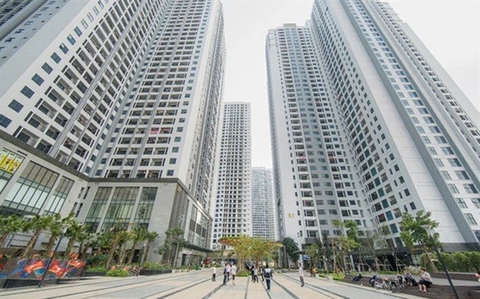Kickstarting upgrades to worker’s housing
Kickstarting upgrades to worker’s housing
The high concentration of industrial zones in big cities has attracted a huge number of workers from rural areas. However, improving their living conditions has become a huge problem that local authorities must deal with.

Although Thach Thi Hong Sa and her husband left the countryside to work for TBS Group in the southern province of Binh Duong 15 years ago, they still can only afford to rent a tiny motel room in a degraded inn at a rate of $43 per month.
Despite the relatively stable working situation, the family can save very little money, and even this can easily disappear if their child gets sick, or another unforeseen expense crops up. The number of families just like Sa’s is countless and even though each has their own situation, the most common point between them is that they moved from the countryside to escape poverty.
In the nearby province of Dong Nai, workers like 45-year-old Neang Soc Nuong live in squalid conditions in between shifts at Chang Shin Company in Thach Phu Industrial Zone (IZ). Two rows of rooms are located opposite each other, with clothes drying in the dark corridor.
Nuong’s room is a daily living space for herself as well as for her husband and adult daughter. All are working for the same company.
“It’s just a temporary place for sleeping overnight,” Nuong told VIR. However, they have “lived temporarily” for more than a decade.
Elsewhere, the surrounding areas of sports shoe manufacturer Pouyuen Vietnam in Binh Tan district of Ho Chi Minh City are famous for motel rooms. Almost every family in this locality has rooms for lease to workers of Pouyuen Vietnam, an enterprise with more than 56,000 workers, the largest one in Ho Chi Minh City.
Dang Thi Phuong Linh, 18 years old and born in the central province of Ha Tinh, is sharing one of these small rooms with two other young women.
Linh said that the cost of rent, electricity, and water for the room, which has no windows, is VND700,000 ($30) per person every month. Normally, Linh goes to work all day and returns at 9pm, so the room is only for sleeping. But during the night, sometimes Linh and her roommates have to get out for more fresh air.
“A higher rental offers better conditions, but we have to save money to send to our families, so this tiny room is acceptable,” Linh said.
Huge demand
Ho Chi Minh City has about 2.2 million workers, and more than 80 per cent of migrant workers have to rent a room in inns. Similarly, Dong Nai province currently has nearly 1.2 million factory workers, nearly all of who must rent privately.
Binh Duong, a predominantly industrial development province, has about 1.6 million workers, most from other provinces. Around 200 companies have built houses for their workers, accommodating 50,000 people.
Statistics from the local authorities revealed that Vietnam currently has 260 IZs operating and more than 16 million workers directly involved in the production system.
According to the Department of Housing and Real Estate Market Development (DHREMD) at the Ministry of Construction (MoC), workers are one of 10 groups of specified subjects supported by social housing in Article 49 of the Law on Housing. However, IZ leaders have been mainly reserving land for building factories, and have not been interested in funding social infrastructure or accommodation.
Houses for workers in IZs are often not available, nor are other facilities such as cultural houses, schools, hospitals, and clinics. Workers, therefore, have to rent accommodation in private inns and live in very low-quality conditions.
According to the DHREMD, there will be more than 163,000 units needed from 2021-2025 for workers in IZs only, excluding around 300,000 social houses and 130,000 units for lower-income earners.
Nguyen Van Loi, general director of Thien Phat Tourism Construction Investment JSC, said that the long-term demand for renting houses for workers is very huge. The company was licensed for a project to build houses for workers a decade ago, and a Japanese corporation that had invested in the high-tech park involved proposed to pay for the rooms for 15 years.
“We wanted to build this project right away, but it is still not easy because we face very complicated procedures,” Loi said.
Similarity, located opposite Loi’s project is a 500 house-for-rent venture with a 50-year land lease term – but although it was started in 2008, no-one knows when it can actually be finished.
While complex procedures are the main issue, the selling price of apartments is controlled by authorities with many strict regulations, which also adds to sluggish movement. Therefore, building social houses is not often on the radar of developers.
According to the MoC, 275 social housing projects with a total of 147,000 apartments have been completed by 2022, while 339 others with a total of about 371,500 units are still under construction. In the first quarter of this year, around 24,000 units were completed in Binh Duong, Kien Giang, Quang Ninh and Bac Ninh provinces. However, this supply is far from the demand.
Huynh Thanh Khiet, deputy director of Ho Chi Minh City Department for Construction, said that in April, around 1,000 social units started construction. “Ho Chi Minh City aims to build 35,000 social houses from 2021 to 2025 and an additional 58,000 units will be added between 2026 and 2040,” he said.
Breakthrough promises
While the authorities and businesses remain hesitant about building social houses, Becamex IDC has succeeded with a low-priced social housing model in Binh Duong province with prices ranging VND100-150 million ($4,350-6,520) per unit.
Over an area of 10 hectares, the Dinh Hoa Social Cluster from Becamex IDC has 20 blocks with 57-157 units in each block. The 30 sq.m units have become almost a dream house for thousands of workers.
Last month, Pham Thieu Hoa, chairman of the Management Board of Vinhomes, announced that in the next five years, it will build 500,000 social units in outskirt areas of Hanoi, Ho Chi Minh City, Haiphong, and Quang Ninh with prices at $13,000-41,300 per unit. These units will also offer facilities such as parks and an entertainment centre for children.
According to Le Hoang Chau, chairman of Ho Chi Minh City Real Estate Association, “With a plan to build 500,000 social houses in five years, this can kickstart a boom for the whole construction industry in Vietnam because the low social housing development results in recent years have been too modest.”
Although the government has issued some policies and incentives to encourage and support housing development for factory workers, there are still many conflicts and challenges in policy implementation.
The Department for Construction of Ho Chi Minh City proposed to expand support policies and loans for households and individuals who newly build or renovate their motels to meet the standards for workers and low-income earners.
In March, the city implemented a package worth $86.9 million to support more than 1.1 million workers. But after two months, only 0.01 per cent was disbursed. “We will push up the appraisal process to give support for more workers in the coming months,” said Tran Thi Dieu Thuy, chairwoman of the Ho Chi Minh City Labour Federation.





















